10 Ways to Source Amazon FBA Wholesale Suppliers
Download Amazon Seller Guide
This guide will help you get started, understand the basics of Amazon selling, and explain in simple words how it all works.
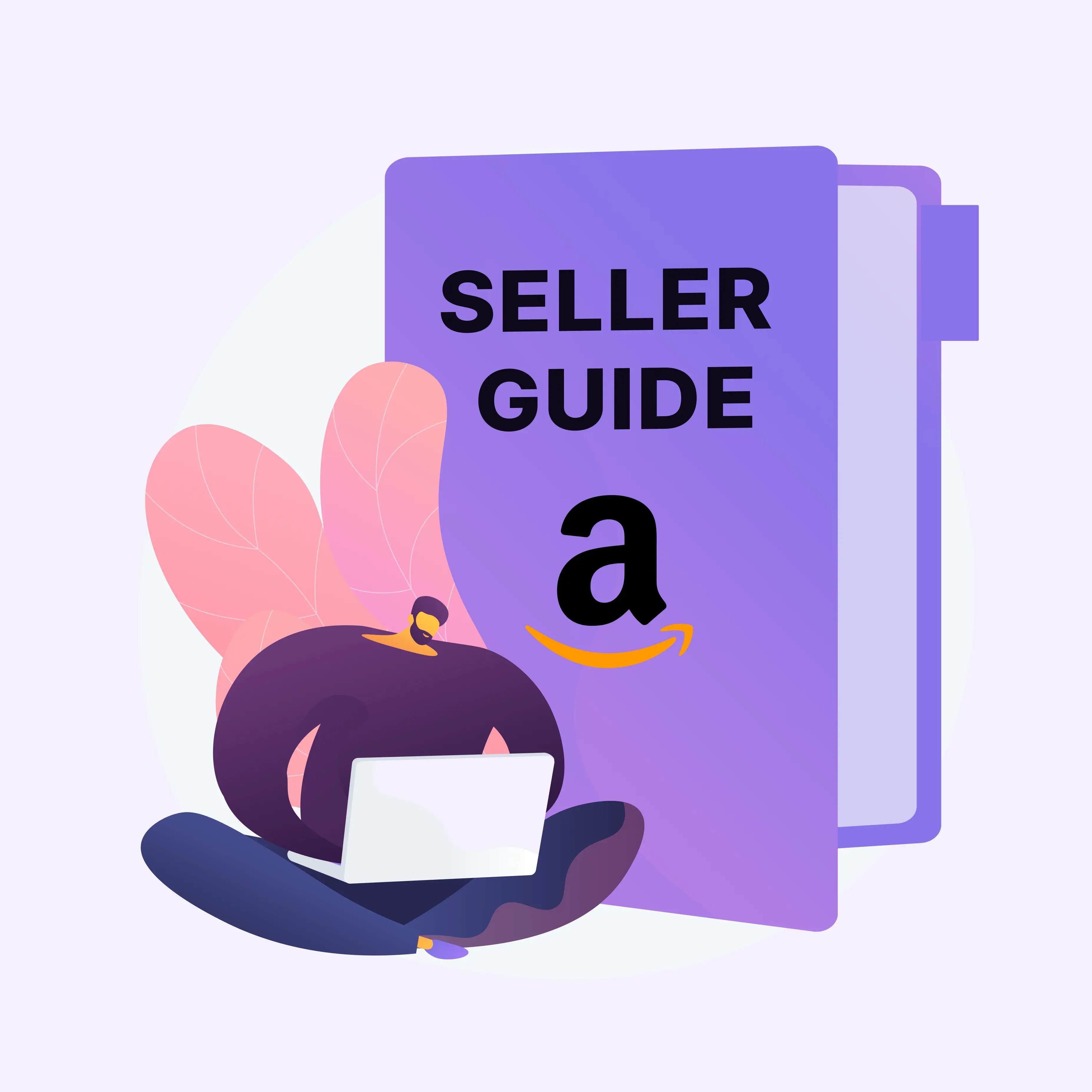
Finding the right Amazon FBA wholesale suppliers is one of the biggest challenges wholesale sellers face. Some brands may be restricted or not profitable to sell on Amazon, while some suppliers may not be reliable, or simply don’t respond. This makes it hard to scale consistently or maintain healthy profit margins.
That’s why having reliable sourcing strategies is critical – you need suppliers you can trust, with products that match your goals. We have a few product research tactics for that.
In this post, you’ll discover 10 proven ways to find high-quality Amazon FBA wholesale suppliers, including how to leverage tools like Brand Analyzer, sourcing directories, curated supplier lists, and more – all tailored to help you source smarter and grow your Amazon business faster.
Strategy 1. Research and Open a Brand
What it is
This strategy involves finding profitable and resale-friendly brands to work with directly by using Seller Assistant's Brand Analyzer. Instead of randomly selecting suppliers, you evaluate each brand’s revenue potential, product range, competition, and resale eligibility to ensure a strategic fit.

How it works
Start by entering a brand name into the Brand Analyzer. The tool will return data points such as the brand’s total number of ASINs, average monthly revenue, number of competing sellers, Amazon in-stock rate, product ratings, and Buy Box prices. Once you’ve identified a suitable brand, reach out to them directly, express your interest in reselling their products, and ask about their pricing structure and Minimum Order Quantities (MOQs).
What Brand Analyzer does

Brand Analyzer delivers a complete snapshot of key indicators – including revenue, competition, stock status, pricing trends, and customer satisfaction. With this data, you can spot resale-friendly brands that offer strong profit potential and are worth pursuing as wholesale partners.
- Brand Analyzer helps you determine whether a brand is suitable for resale and a good candidate to approach as a supplier.
- It streamlines the brand evaluation process by automating key research steps, saving you time when identifying profitable wholesale opportunities.
- The tool estimates a brand’s total monthly sales volume by aggregating revenue across its full product lineup.
- It reveals how often Amazon wins the Buy Box for that brand’s listings, helping you understand the level of direct competition.
- You can also see how many third-party FBA sellers typically compete on each product, giving you a clearer view of margin pressure and market saturation.
- Brand Analyzer shows the size of the brand’s catalog by listing how many products it carries, which helps gauge overall market presence.
- It assesses customer sentiment by analyzing the volume of reviews and average star ratings across the brand’s products.
- You’ll also get access to the average Buy Box prices, which supports better pricing strategy and profit estimation.
- For cost forecasting, it includes average FBA fees per product, so you can factor in fulfillment expenses more accurately.
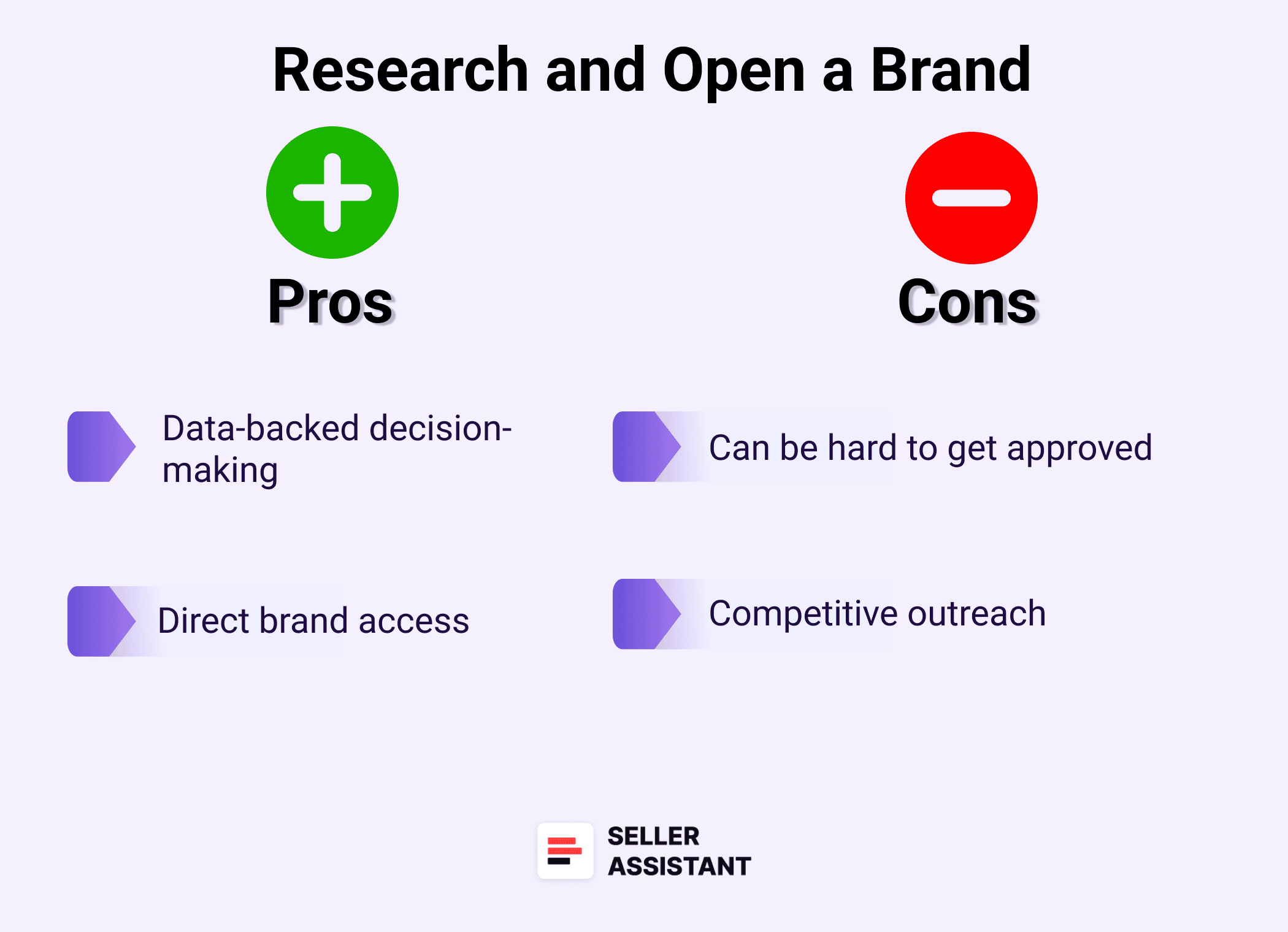
Pros
- Data-backed decision-making
You’re not guessing – you’re choosing brands based on real sales data, competition levels, and profit estimates, which increases your chances of success.
- Direct brand access
Working directly with brands often leads to better pricing, fewer restrictions, and long-term partnership opportunities.
Cons
- Can be hard to get approved
Brands may be selective with resellers and often require proof of existing sales, strong business credentials, or specific volume commitments. Sometimes you might need to get ungated to sell certain products.
- Competitive outreach
Many sellers may be reaching out to the same brands, so standing out in your pitch and follow-up is essential.
Best for
Sellers who want to establish long-term brand relationships, avoid middlemen, and build a scalable wholesale operation with higher margins. This is a great way to improve your unit economics.
Note. Seller Assistant is a comprehensive product-sourcing software that helps Amazon sellers quickly find high-profit deals. It combines three extensions: Seller Assistant Browser Extension, and IP-Alert Chrome Extension by Seller Assistant, and VPN by Seller Assistant, Amazon seller tools: Price List Analyzer, Brand Analyzer, Seller Spy, Bulk Restrictions Checker, and API integrations, and features: Storefront Widget, Side Panel View, FBM&FBA Profit Calculator, Quick View, Stock Checker, IP Alert, Variation Viewer, Sales Estimator, Offers, and Restrictions Checker.
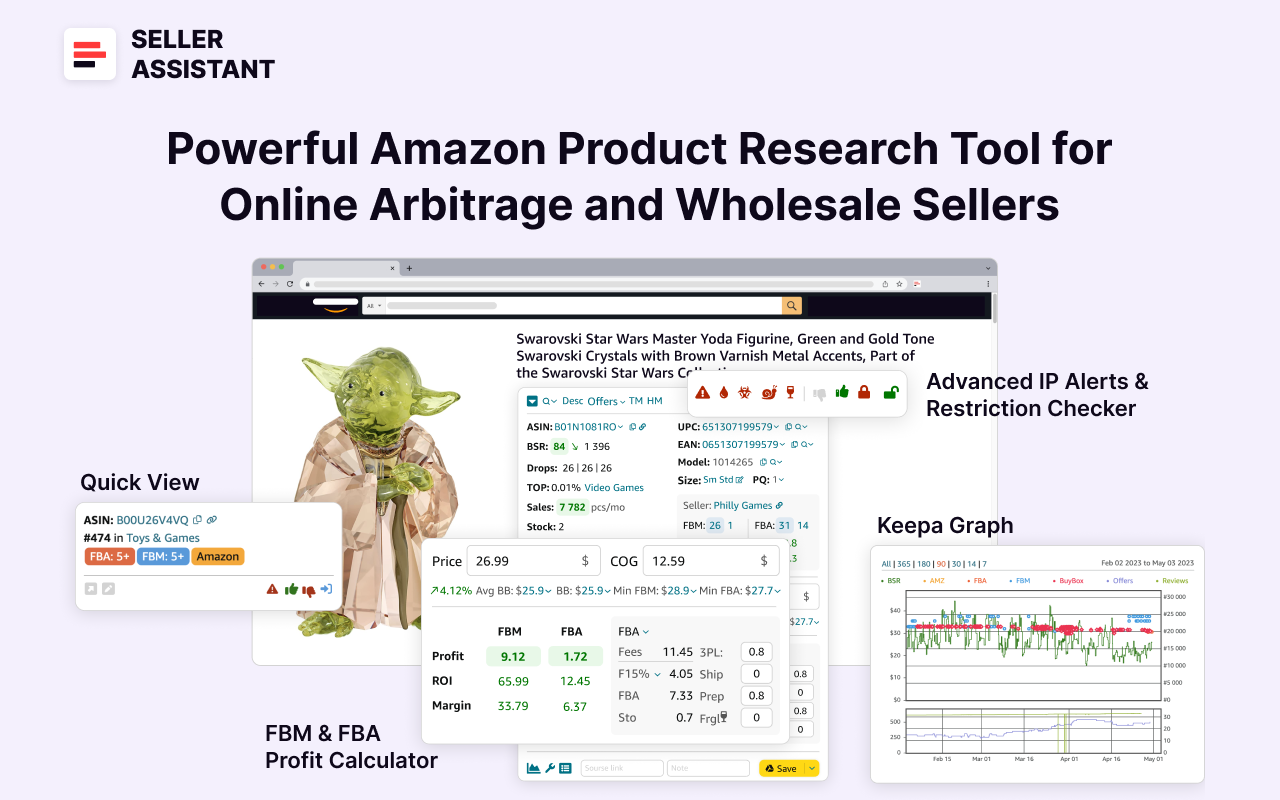
It offers a robust toolkit of over 20 features built to streamline every part of the sourcing process – from bulk scanning wholesale supplier sheets for high-margin leads to deep product research and advanced brand and competitor analysis. By using this FBA and FBM product sourcing software, you can easily identify products that have the potential to be sold well on Amazon.
Strategy 2. Find Verified U.S. Distributors with Sourcing AI
What it is
Sellers can now use AI-powered tools to find wholesale suppliers faster and more accurately than ever before. Sourcing AI by Seller Assistant does exactly that. It’s designed to help Amazon FBA wholesale sellers uncover verified U.S.-based distributors for specific brands – especially those with large-volume or authorized reseller programs.
Built with real Amazon business workflows in mind, Sourcing AI mimics how experienced sellers source inventory: it searches structured product data and returns a table with key sourcing details like supplier name, product description, price, link, MOQ, and notes – streamlining the wholesale sourcing process from start to finish.
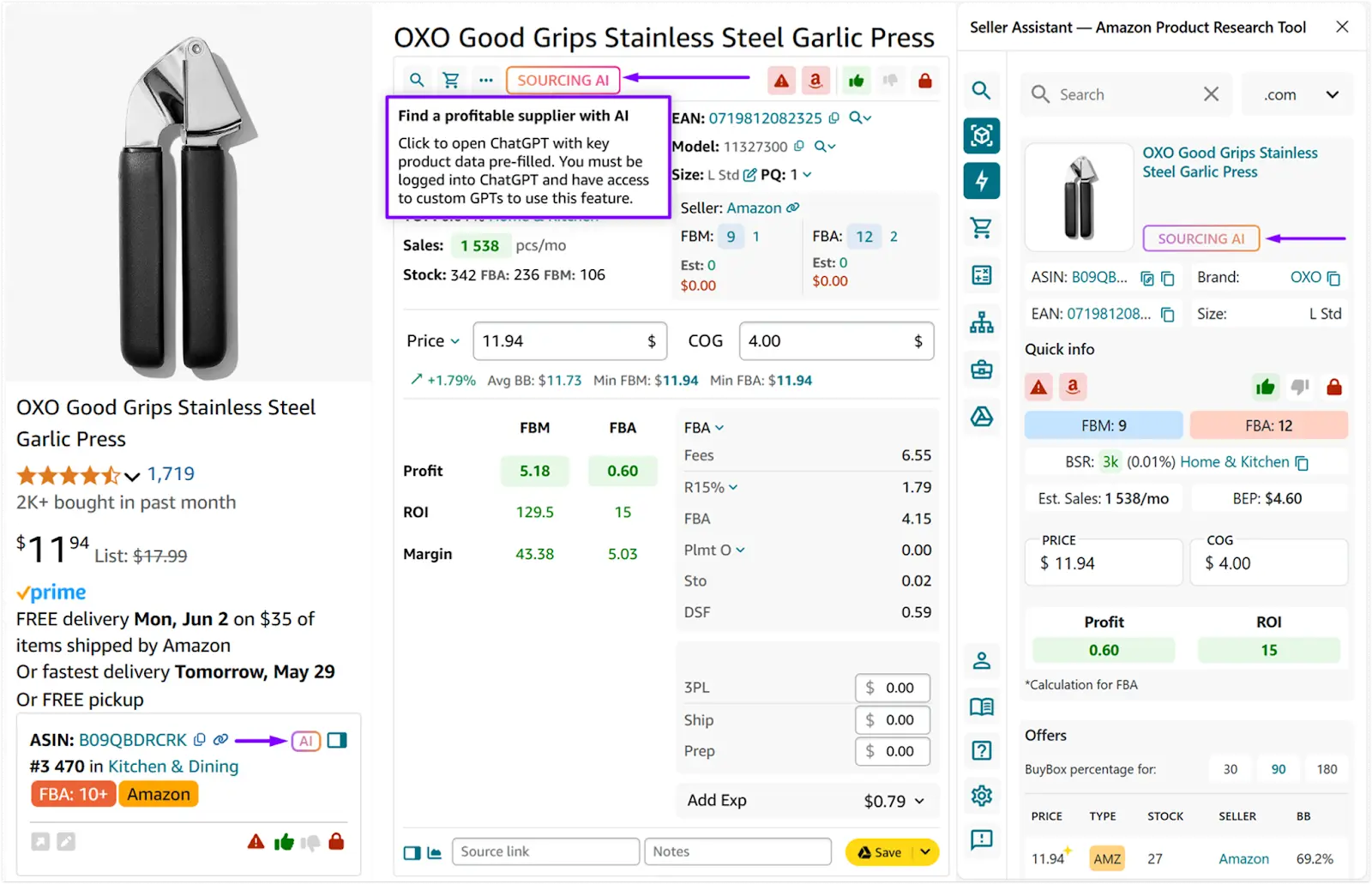
How it works
Start by visiting Amazon’s product page, search results, a competitor’s storefront, or the Seller Assistant Side Panel View. From there, click the “Sourcing AI” button and enter your request, such as: “Find suppliers of [Brand Name] in the U.S.”
Within seconds, Sourcing AI will return a detailed table of up to 10 matching suppliers, showing:supplier name, product description, price, direct link, Minimum Order Quantity (MOQ), and additional notes.
Each result is flagged as an exact or likely match, so you can focus your attention on the most credible sourcing opportunities.
What Sourcing AI does
%2520(1)%2520(1).png)
Sourcing AI is built to help Amazon FBA sellers find real, profitable U.S.-based wholesale suppliers – fast. It follows Amazon seller logic and is packed with functionality designed for speed, precision, and sourcing confidence:
- Product matching by identifier
Finds exact or likely matches by using ASINs, UPCs, model numbers, or part numbers to locate the right products from suppliers.
- Verified U.S. suppliers only
Filters out international platforms like Alibaba, Temu, and eBay – focusing solely on trusted U.S. distributors and wholesale partners.
- Max COG filter
Automatically excludes suppliers whose prices exceed your defined maximum cost of goods – ensuring offers stay within your target margins.
- Detailed supplier table
Returns up to 10 results with essential details: Supplier name, Product Description, Price, Link, SKU, MOQ, and Match Confidence (Exact or Likely).
- Works directly from Amazon
Access Sourcing AI inside Seller Assistant’s toolkit:
- Amazon product pages (Seller Assistant)
- Search results (Quick View)
- Any supplier site (Side Panel View)
- Competitor storefronts (Storefront Widget).
- Warnings and prompts
Flags missing product data, potential bundles/multipacks, or low-confidence matches – so you can validate before taking action.
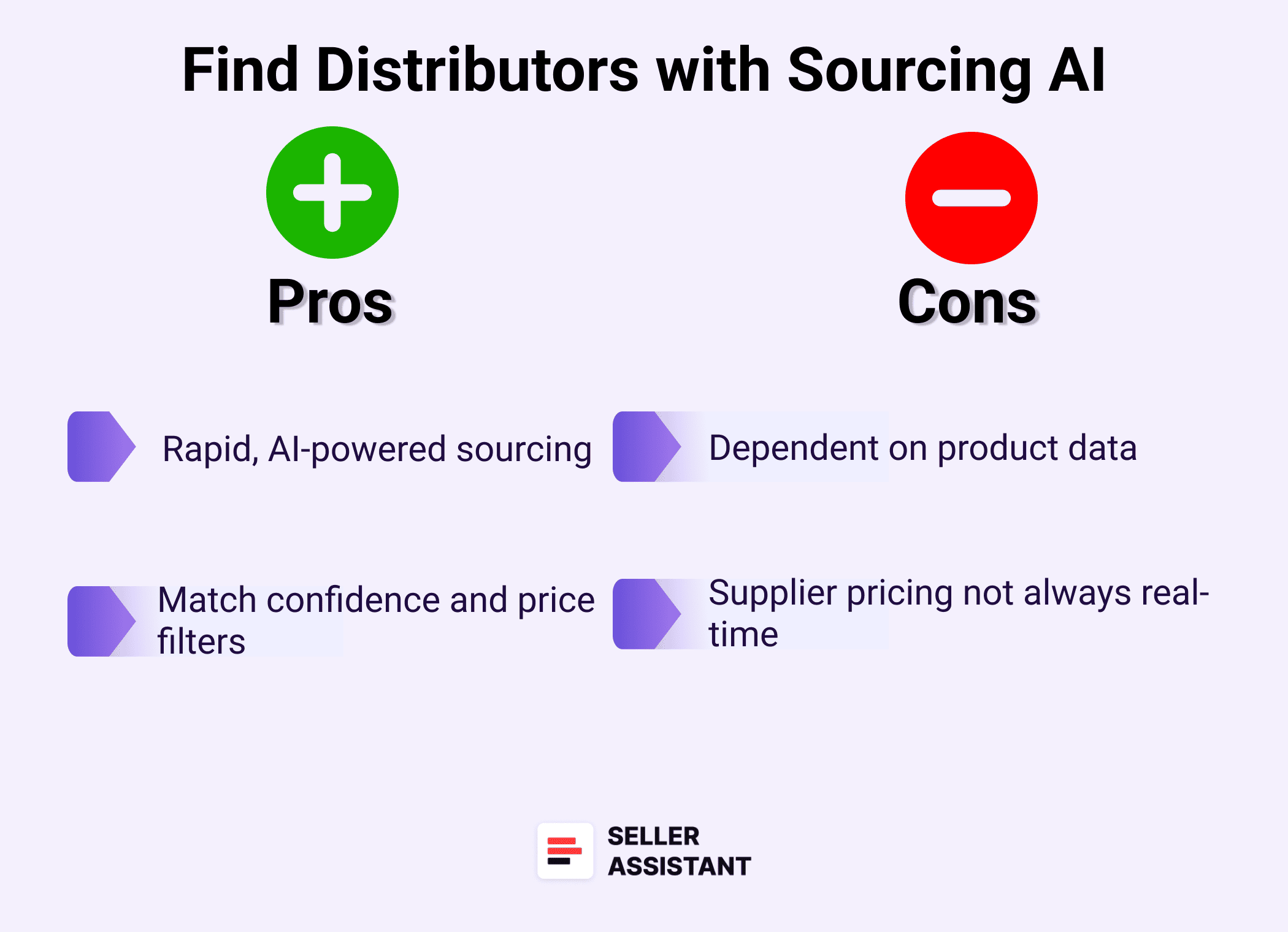
Pros
- Rapid, AI-powered sourcing
What normally takes hours of research is handled in seconds. Sourcing AI automates the discovery process and gives you ready-to-act supplier leads directly within your browser.
- Match confidence and price filters
The tool flags exact matches based on UPCs or model numbers and filters out suppliers who exceed your Max COG – helping you avoid mistakes and focus on profitable opportunities.
Cons
- Dependent on product data
If key identifiers like UPC or model numbers are missing from the Amazon listing, match confidence may drop, requiring manual review or validation.
- Supplier pricing not always real-time
While the tool pulls from public supplier websites, availability and pricing should still be confirmed before ordering, as they might not reflect live updates.
Best for
Wholesale FBA sellers looking to open new brand accounts through verified U.S. distributors. Also ideal for online arbitrage sellers and dropshippers needing fast, accurate sourcing options with margin filters.
Strategy 3. Source Through Authorized Brand Distributors
What it is
Instead of working directly with the brand, this strategy involves finding and partnering with one of the brand’s authorized distributors. These are third-party wholesalers officially approved to resell the brand’s products – often with lower minimum order quantities and more flexible onboarding terms.
How it works
Start by visiting the brand’s official website and checking for a “Where to Buy”, “Authorized Distributors”, or “Wholesale Partners” section. These pages typically list approved distributors by region or industry. Contact the distributors directly to inquire about opening a wholesale account, understand their resale terms, and request product catalogs or price lists.
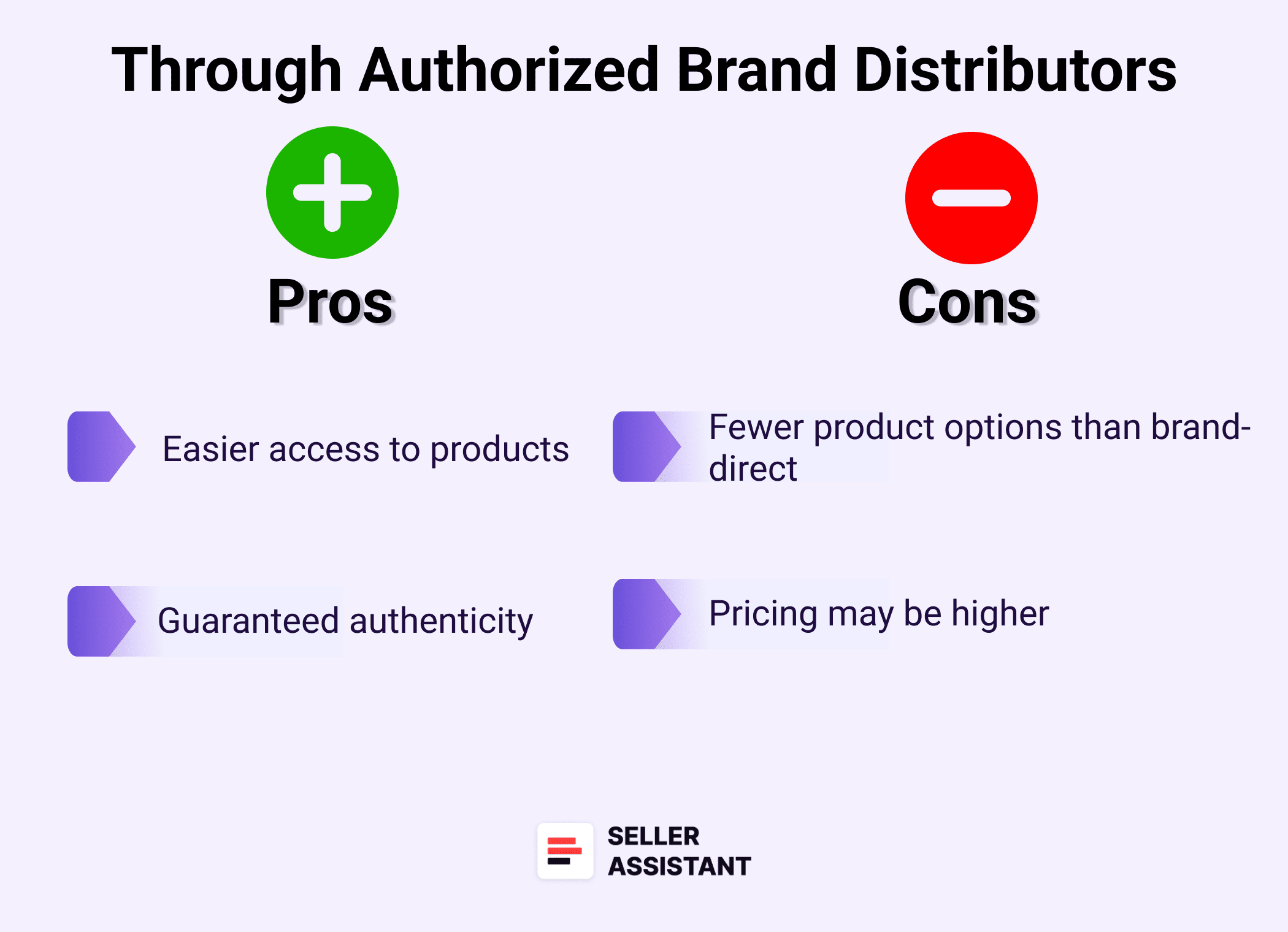
Pros
- Easier access to products
Authorized distributors often have smaller MOQs and faster account approval than going directly through the brand, making them ideal for newer sellers.
- Guaranteed authenticity
Since these suppliers are vetted by the brand, you're ensured access to legitimate, high-quality inventory with minimal risk of IP claims or counterfeit issues.
Cons
- Fewer product options than brand-direct
Distributors may carry only a subset of the brand’s catalog – meaning you might miss out on exclusive items or latest releases.
- Pricing may be higher
Because distributors add their own markup, the wholesale prices may be slightly less competitive compared to ordering directly from the brand.
Best for
Sellers who want to sell branded products but may not meet a brand’s direct requirements (like high MOQs or established resale history). Great for building a diversified inventory without jumping through brand-level hoops.
Strategy 4. Leverage Existing Suppliers to Discover New Ones
What it is
Many wholesale suppliers distribute products from multiple brands – which makes them a valuable lead source for expanding your product catalog. By tapping into your existing supplier relationships, you can uncover additional brands or connected suppliers they already work with.
How it works
Once you’ve built a relationship with a supplier, they typically provide a price list covering all the brands they distribute. To identify new opportunities, scan this list for brands you haven’t sourced yet.
Use Seller Assistant's Brand Analyzer to evaluate each brand’s product range, revenue potential, competition, and resale eligibility. Based on that analysis, decide which additional brands are worth pursuing – giving you a data-backed way to expand your inventory through a supplier you already trust.
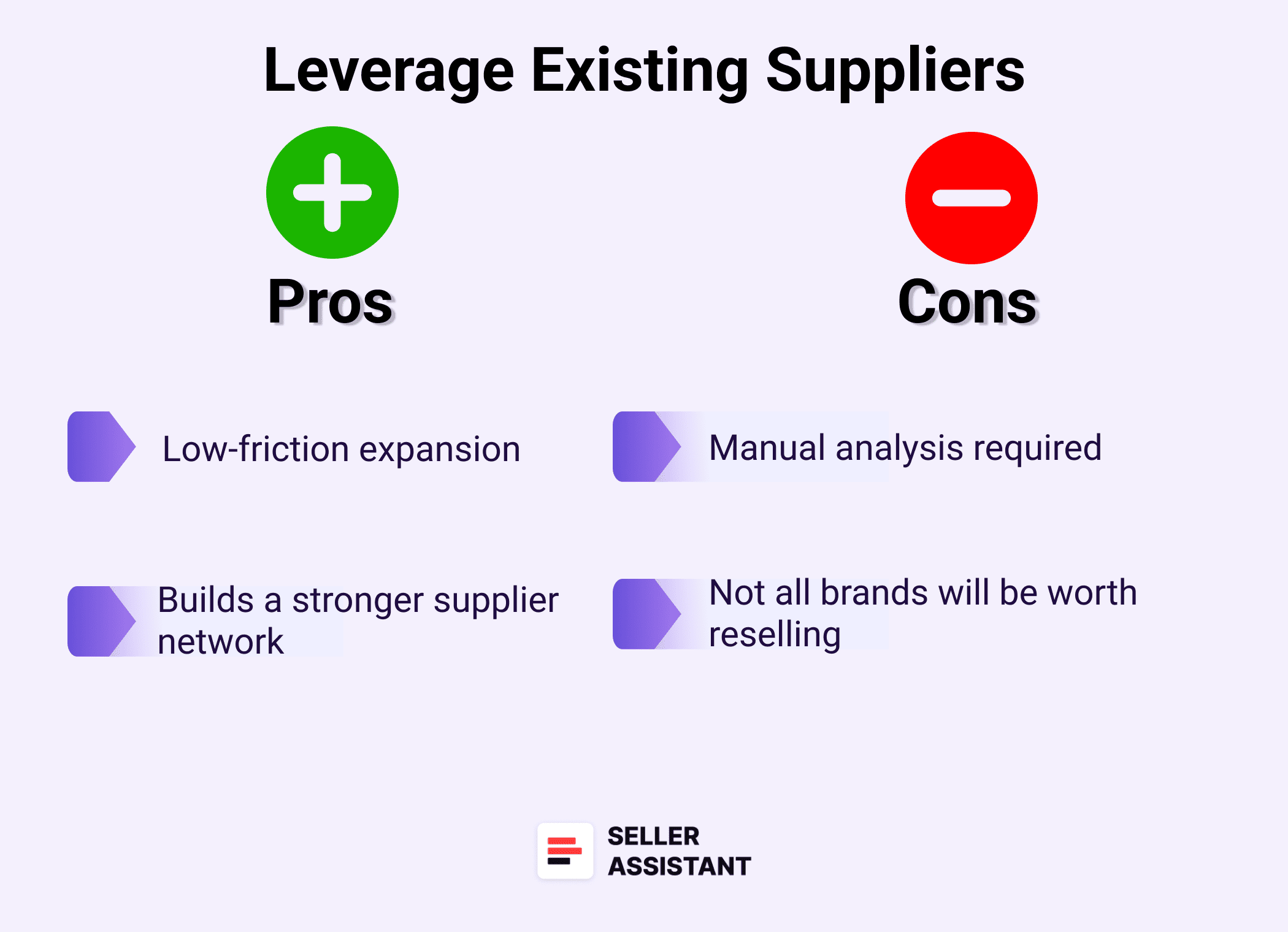
Pros
- Low-friction expansion
Because you're already doing business with the supplier, they’re more likely to offer insights or help you access new brands with minimal onboarding.
- Builds a stronger supplier network
This strategy helps you move beyond isolated deals and create a network of vetted suppliers, improving your long-term sourcing flexibility.
Cons
- Manual analysis required
Even though you receive the full price list, identifying new opportunities still requires detailed product and brand analysis.
Tip. To automate separating good deals from dead inventory, you can use tools like Seller Assistant's Brand Analyzer and Price List Analyzer. Brand Analyzer helps evaluate the profitability and competitiveness of entire brands based on real Amazon data. Price List Analyzer matches supplier UPCs/EANs to ASINs and fills your spreadsheet with key metrics like profit, ROI, sales velocity, and restrictions – so you can instantly filter for winning deals and create a purchase shortlist.
- Not all brands will be worth reselling
Some brands on the list may have poor profit margins, high competition, or Amazon dominance, making them unsuitable for your FBA strategy despite being readily available through your supplier.
Best for
Sellers who already work with one or more wholesale suppliers and want to deepen the relationship while expanding their brand access organically. Works especially well for niche-focused sellers looking for new product lines within the same category.
Strategy 5. Focus on a Specific Niche Market
What it is
Instead of targeting broad or oversaturated categories like electronics, home décor, or toys, this strategy focuses on selecting a narrow product niche with specific customer demand and lower competition.
Examples of niche markets
Eco-friendly pet grooming supplies, tactical outdoor gear, allergy-safe snacks, or ergonomic accessories for remote workers.
By specializing in a focused category, sellers can better understand customer needs, spot underserved sub-niches, and tailor their sourcing strategy accordingly. Niche sellers often build stronger supplier relationships, face less direct competition, and enjoy better pricing leverage by becoming subject-matter experts in their space.
How it works
Choose a niche you're familiar with or that shows strong demand and profitability on Amazon. Use Sourcing AI, search engines and B2B directories to find U.S.-based distributors or wholesale suppliers that specialize in that segment. Because you’re targeting a defined market, it’s easier to tailor your outreach, negotiate terms, and build lasting relationships with specialized suppliers.
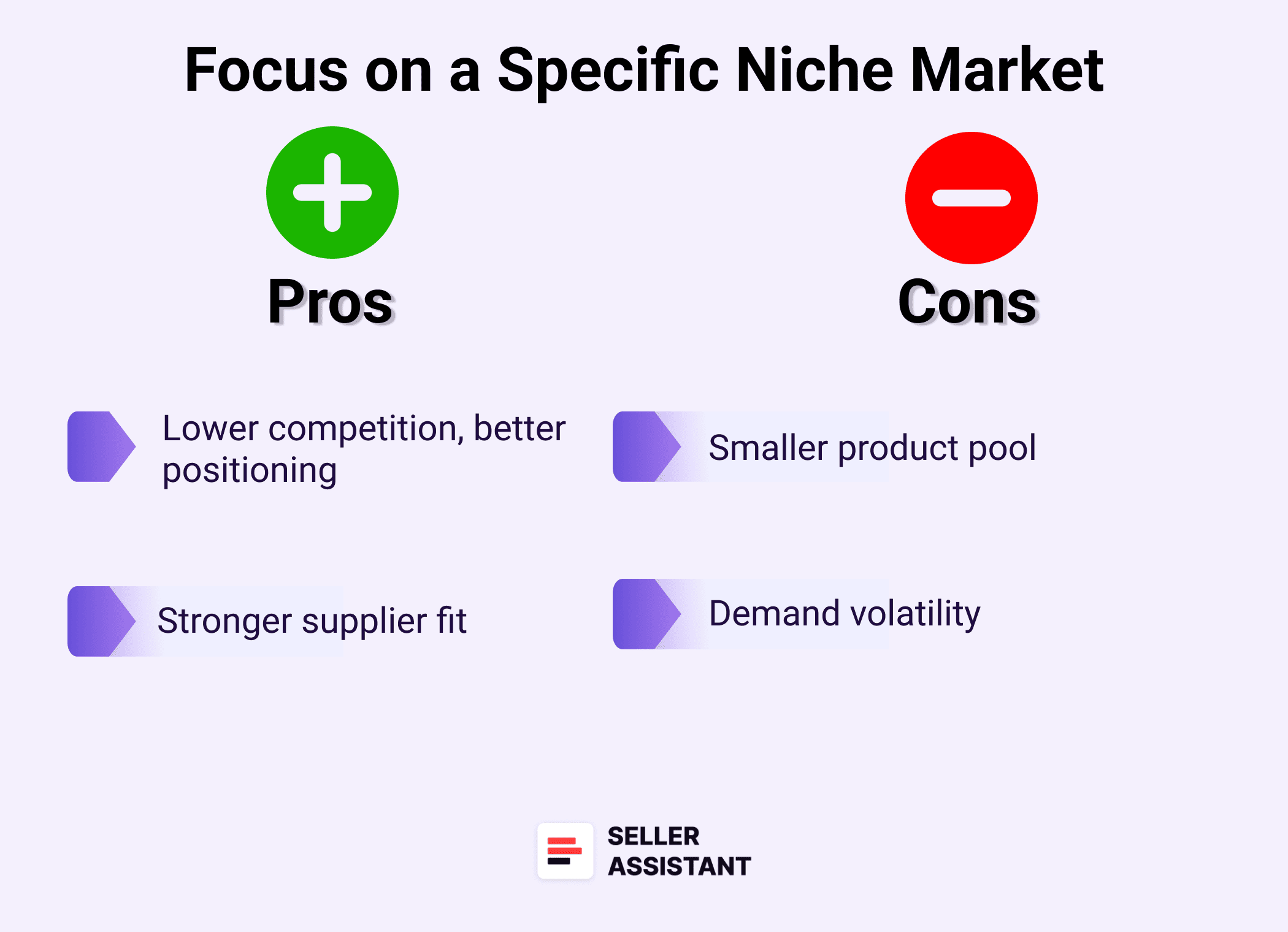
Pros
- Lower competition, better positioning
Focusing on a niche makes it easier to stand out and build expertise – reducing exposure to saturated markets and price wars.
- Stronger supplier fit
Niche distributors are often more responsive and supportive because they value working with sellers who truly understand their products and customers.
Cons
- Smaller product pool
Niche markets often have fewer available SKUs, which may limit how much inventory you can source from each supplier.
- Demand volatility
If demand shifts or trends fade, niche categories can lose momentum faster than broader categories – requiring consistent market research.
Best for
Sellers who want to specialize in a category, build domain authority, and work with suppliers that value focused, knowledgeable partners. Ideal for scaling up with precision rather than volume.
Strategy 6. Partner with Local and Regional Brands
What it is
Local and regional brands – especially small, family-owned businesses or niche manufacturers – often offer excellent wholesale opportunities for Amazon sellers. These brands may not be widely available on Amazon yet, giving you the chance to introduce unique, low-competition products to the marketplace while building direct supplier relationships.
How it works
Research regional brands in your target category using Google, local business directories, trade associations, or even Amazon itself. Focus on smaller “mom-and-pop” brands that are less likely to have a saturated seller base.
Reach out via phone or email, introduce your business, and offer to become a reseller. These brands are often open to flexible deals and may be looking for new sales channels – especially if you already sell other products from their region or category.
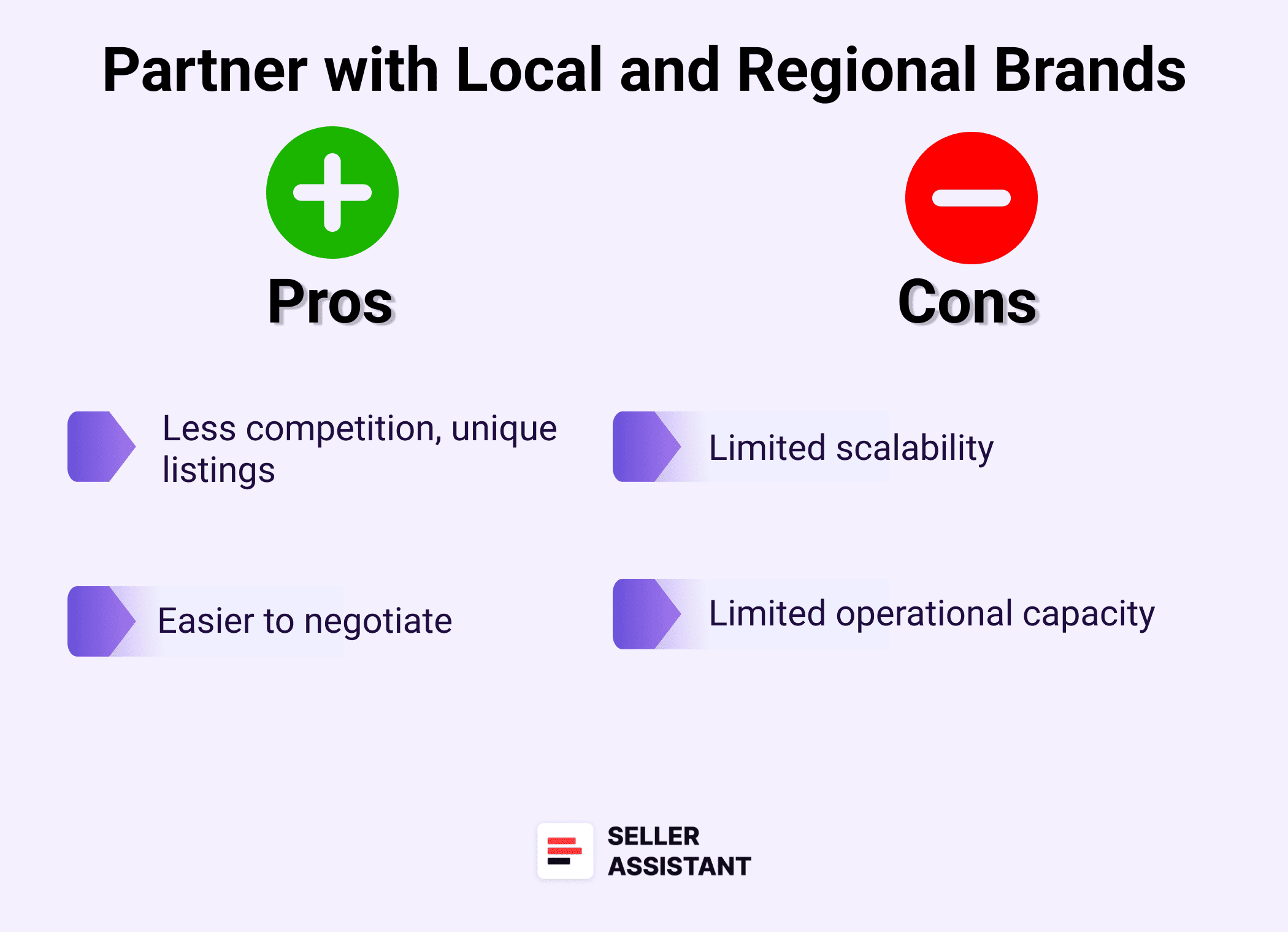
Pros
- Less competition, unique listings
Since many local brands have limited Amazon presence, you can build exclusive listings or enjoy early-mover advantage with reduced competition. A good strategy is selling bundles on Amazon.
- Easier to negotiate
Small businesses are often more open to custom agreements, flexible minimums, and personal communication – making onboarding smoother and more collaborative.
Cons
- Limited scalability
Local brands may have smaller inventories, limited production capacity, or slower fulfillment processes – making them less suited for rapid scaling.
- Limited operational capacity
Many small or local brands may not have systems in place for high-volume orders, timely restocking, or frequent wholesale invoicing. This can lead to delays, communication gaps, or fulfillment challenges as your business scales.
Best for
Sellers looking to build a curated catalog of under-the-radar products with strong branding and low competition. Especially useful for those focused on region-based niches, handmade goods, or launching exclusive Amazon listings.
Strategy 7. Follow the Supplier’s Distribution Network
What it is
This strategy involves using your existing connections to trace supplier networks and discover additional Amazon FBA wholesale suppliers linked to brands or products you're already sourcing. Many suppliers are part of broader distribution chains – and tapping into those connections can unlock new sourcing channels that are pre-vetted and relevant to your product category.
How it works
Reach out to your current suppliers and ask about their upstream or downstream distribution partners. Some may work with larger wholesalers, regional reps, or manufacturers who serve multiple resellers.
You can also investigate their product catalogs for clues about partner brands or distribution centers. This approach helps you uncover suppliers that might not show up in online directories but are trusted players in the supply chain.
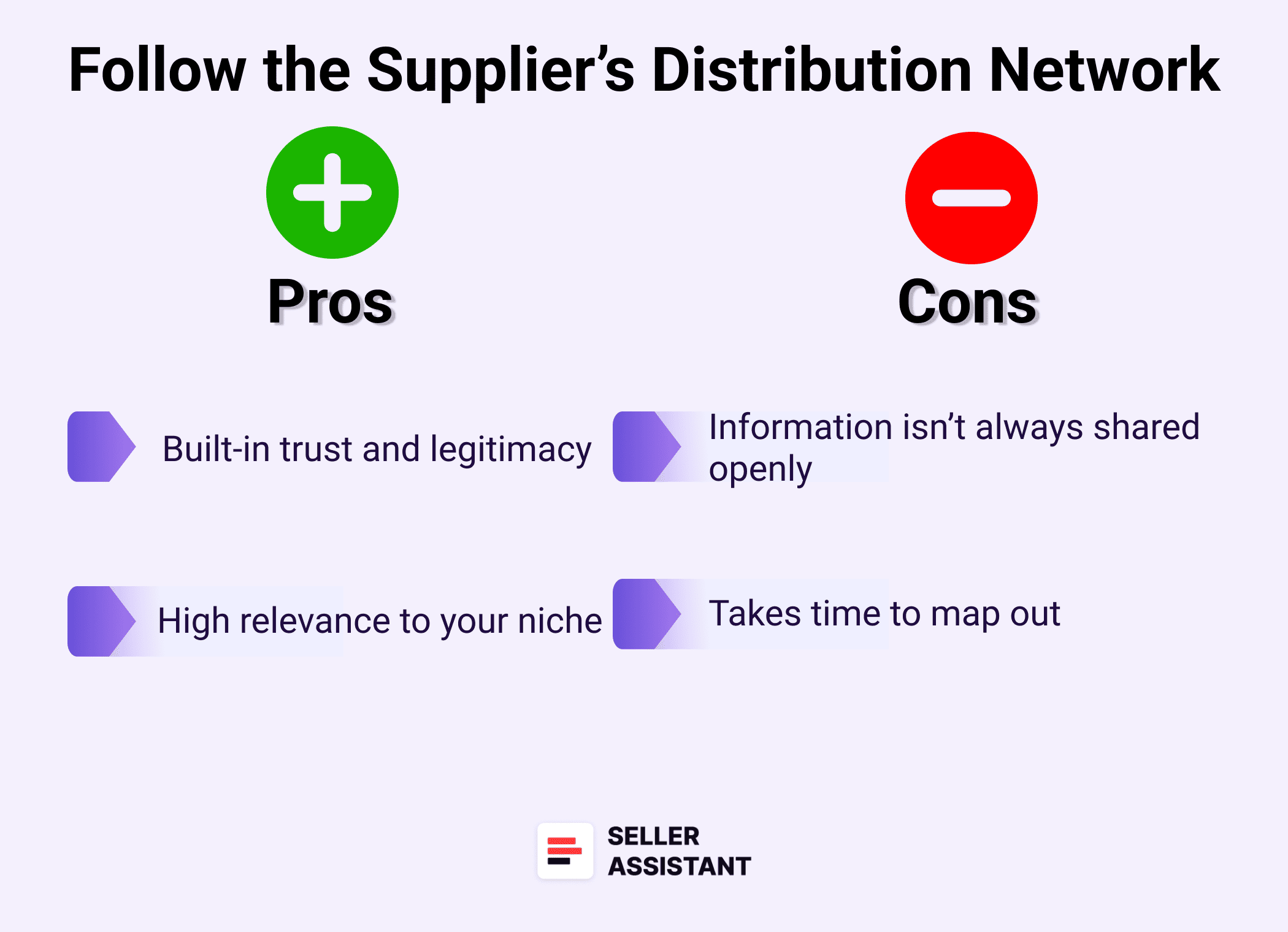
Pros
- Built-in trust and legitimacy
Suppliers within the same distribution chain often operate under established agreements, reducing your risk of counterfeit or gray-market products.
- High relevance to your niche
Because they’re linked to your current inventory, these suppliers usually carry similar or complementary products – making them a natural fit for expansion.
Cons
- Information isn’t always shared openly
Some suppliers may be hesitant to disclose their network, especially if they see you as a competitor or if they lack strong relationships with their partners.
- Takes time to map out
Identifying and contacting relevant distributors through the network can be a slow, manual process – especially without introductions.
Best for
Sellers who already work with a few established suppliers and want to expand their sourcing by digging deeper into proven distribution networks. Especially effective for sellers who focus on consistent supply over trend-chasing.
Strategy 8. Use Wholesale Supplier Directories
What it is
Wholesale directories are curated databases of manufacturers, distributors, and Amazon FBA wholesale suppliers across various categories. These platforms offer an easy way to discover new sourcing partners without hours of individual research – especially when you're just starting or expanding into a new niche.
How it works
Sign up for reputable directories like SaleHoo, Worldwide Brands, or Wholesale Central. These directories let you filter suppliers by product category, location, MOQ, or shipping policy. Once you identify potential partners, you can contact them directly to request their catalogs, verify reseller terms, and begin building relationships.
Top wholesale supplier directories for Amazon sellers
A popular paid directory offering 8,000+ vetted suppliers, especially strong in branded and niche consumer goods.
Lifetime-access directory with over 16 million products and certified wholesale suppliers.
A free directory of U.S.-based wholesalers and dropshippers. Not curated as tightly as others, but useful for quick searches.
Primarily known for dropshipping automation, but also offers a supplier directory with integration-ready partners.
A massive industrial supplier database for U.S.-based B2B sourcing. Best for niche, non-retail products.
A wholesale marketplace focused on independent brands and makers – ideal for sourcing exclusive or artisan products.
Commission-free wholesale platform with direct access to independent U.S. brands. Strong in home, lifestyle, and gift categories.
B2B platform that lists wholesalers, manufacturers, and distributors across many product categories.
European fashion-focused wholesale directory, ideal for sellers interested in branded clothing and accessories.
U.S.-based supplier directory of niche home décor and gifts – especially helpful for sellers in lifestyle categories.
Pros
- Fast supplier discovery
Directories give you instant access to hundreds of pre-listed suppliers – reducing the time needed to find new contacts from scratch.
- Useful for beginners
If you're new to wholesale sourcing, directories can provide a vetted, low-risk entry point into finding and evaluating suppliers across many product categories.
Cons
- Mixed supplier quality
While most directories vet their listings, not all suppliers offer competitive pricing, reliable inventory, or strong Amazon compatibility – so you still need to do due diligence.
- Limited exclusivity
Since many sellers access the same directories, it’s harder to secure exclusive deals or discover hidden opportunities through this method alone.
Best for
New and mid-level sellers looking for a wide range of wholesale options without deep supplier research. Ideal for those exploring new categories or building supplier diversity efficiently.
Strategy 9. Visit Trade Shows and Industry Events
What it is
Trade shows and B2B industry expos are powerful offline channels to meet Amazon FBA wholesale suppliers face-to-face. These events gather hundreds of manufacturers, distributors, and brand reps in one place – offering a rare chance to network, evaluate products hands-on, and build supplier relationships with high trust and speed.
How it works
Search for industry-specific trade shows in your product category (e.g., toys, beauty, home goods, or food) using platforms like 10times.com, TSNN, or ExpoGuide.
Attend events prepared: bring business cards, your reseller documentation, and be ready to pitch your Amazon storefront as a valuable distribution partner. Use the opportunity to collect catalogs, ask about wholesale programs, and negotiate terms in real-time.
Top U.S. trade shows for sourcing wholesale suppliers
- ASD Market Week (Las Vegas, NV)
One of the largest B2B trade shows in the U.S., covering general merchandise, fashion, electronics, home goods, and more.
- Toy Fair® (New York, NY)
Premier event for the toy, game, and youth entertainment industry – great for Q4 prep and brand partnerships.
- Natural Products Expo West (Anaheim, CA)
Major show for organic and natural food, wellness, beauty, and supplements – ideal for health-conscious and premium product sellers.
- NY NOW (New York, NY)
Focused on home, lifestyle, gift, and artisan goods – strong for niche and seasonal sourcing.
- Fancy Food Show (New York, NY & Las Vegas, NV)
The largest specialty food and beverage event in North America, featuring gourmet, ethnic, and trending food brands.
Designed for eCommerce sellers and Amazon brands – connects you with private label manufacturers, packaging firms, and suppliers.
Ideal for pet-focused sellers – covers everything from grooming products and treats to toys and accessories.
- The Inspired Home Show (Chicago, IL)
The largest U.S. housewares show – covers kitchenware, cleaning, storage, and lifestyle essentials.
- Licensing Expo (Las Vegas, NV)
Perfect for sellers looking to work with officially licensed products, characters, and brand partnerships.
- MAGIC Las Vegas / SOURCING at MAGIC (Las Vegas, NV)
Leading trade show for apparel, fashion, footwear, and sourcing – ideal for clothing sellers and private label research.
Pros
- Meet suppliers face-to-face
You can build trust, ask detailed questions, and make a memorable impression – all of which help speed up account approvals and deal-making.
- Discover hidden and emerging brands
Many small or growing brands attend trade shows looking for resellers, making it a prime opportunity to find untapped or exclusive products for Amazon.
Cons
- Travel and attendance costs
Attending trade shows may involve travel, accommodation, and entry fees – which can add up, especially for smaller sellers.
- Limited follow-up success if unprepared
If you don’t come with a clear pitch, reseller documentation, or post-show follow-up plan, you risk losing the momentum of connections made during the event.
Best for
Sellers who are serious about scaling through exclusive brand relationships, discovering up-and-coming wholesale suppliers, or those looking to diversify beyond online sourcing methods.
Strategy 10. Use Curated Supplier Lists
What it is
For sellers who want a shortcut to finding verified Amazon FBA wholesale suppliers, curated supplier lists offer a fast-track solution. These lists compile pre-researched, trustworthy U.S. suppliers across multiple categories, allowing you to skip the discovery phase and jump straight into building relationships.
How it works
Seller Assistant offers a curated List of 500+ US suppliers. Simply select suppliers relevant to your category, request their price lists, and upload them into Seller Assistant’s Price List Analyzer to instantly identify profitable, reseller-friendly deals. You can apply filters for ROI, profit, restrictions, and sales velocity – eliminating hours of manual vetting.
Pros
- Saves research time
Instead of spending hours on Google or vetting unknown directories, you get immediate access to high-quality, resale-friendly suppliers.
- Compatible with bulk deal analysis
When combined with Price List Analyzer, you can instantly match supplier inventory to Amazon ASINs, check eligibility, and shortlist the best products for resale.
Cons
- Not fully exclusive
Other sellers may access the same supplier list, so competition is still possible – making product-level analysis crucial.
- Requires price list follow-up
You’ll still need to contact each supplier individually to request their pricing and verify account requirements before buying.
Best for
Busy or newer sellers looking to scale faster by working with pre-vetted Amazon FBA wholesale suppliers, without the upfront burden of sourcing from scratch.
FAQ
What are Amazon restricted brands?
Amazon restricted brands are those that require approval before you can sell them on the platform. These restrictions help protect intellectual property, prevent counterfeiting, and ensure only authorized sellers list these products.
How do I know if a brand is restricted?
You can check if a brand is restricted by using the "Add a Product" section in Seller Central. If a brand is restricted, you will see an "Apply to Sell" button, which means you need approval to list it. You can also use tools like Seller Assistant's Restrictions Checker to see restrictions in one click.
Can I sell a restricted brand without approval?
No, you cannot list a restricted brand without obtaining prior approval from Amazon. Amazon will not allow you to list your offers until you get approval.
What happens if a brand I sell becomes restricted?
If a brand becomes restricted after you've already listed it, Amazon will notify you in your Account Health Dashboard and via email. You will need to take corrective action, such as applying for approval or removing the offer, to avoid further penalties.
Final Thoughts
Finding the right Amazon FBA wholesale suppliers is critical to your success — but it doesn’t have to be overwhelming. By applying the 10 proven sourcing strategies covered in this post, you can streamline supplier discovery, avoid dead inventory, and build long-term relationships with profitable brand partners.
To make sourcing faster, smarter, and more data-driven, use tools like Seller Assistant. With tools like Price List Analyzer, Brand Analyzer, and Sourcing AI, it gives you the automation and insights needed to identify high-margin deals and make confident sourcing decisions at scale.
Seller Assistant is an all-in-one product sourcing software offering all the features vital for product sourcing. It combines three extensions: Seller Assistant Extension, IP Alert, and VPN by Seller Assistant, tools: Price List Analyzer, Brand Analyzer, Seller Spy, Bulk Restrictions Checker, and API integrations, and features: Storefront Widget, Side Panel View, FBM&FBA Profit Calculator, Quick View, Stock Checker, IP Alert, Variation Viewer, Sales Estimator, Offers, Restrictions Checker, and other features that help quickly find high-profit deals. Seller Assistant also offers integration with Zapier allowing to create custom product sourcing workflows.
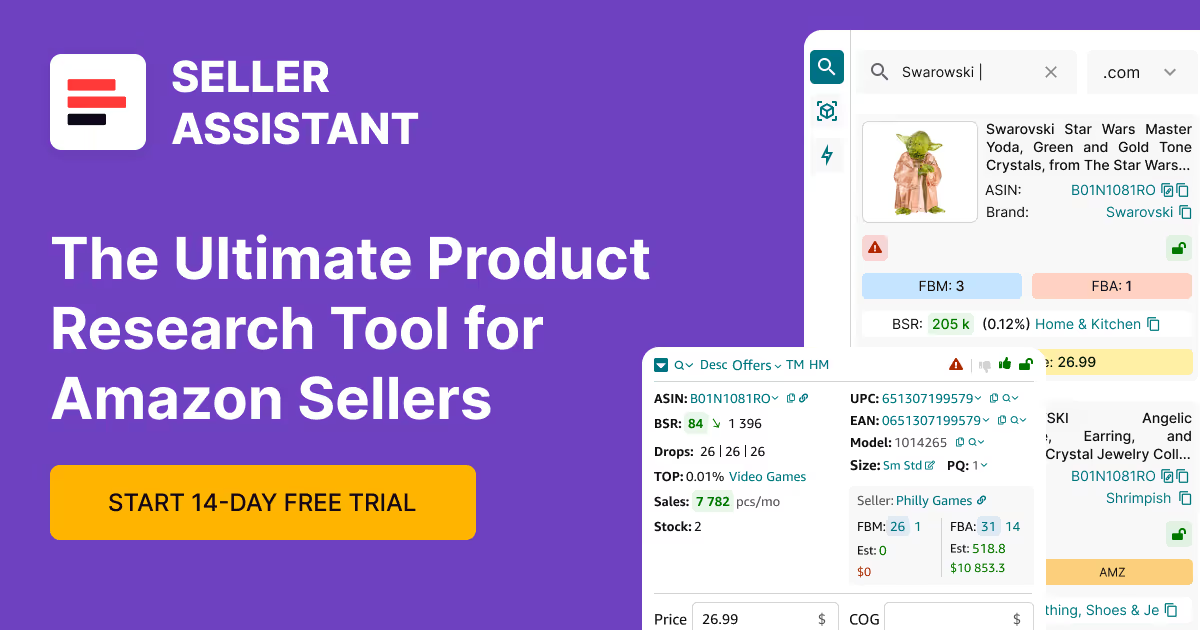
.svg)













